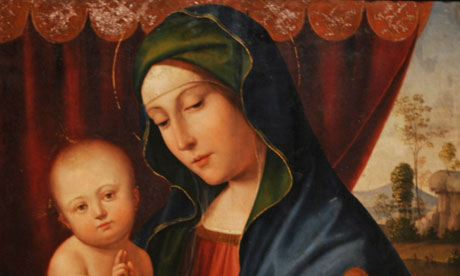National Gallery: an art exhibition where nothing is what it seems
A fascinating new show examines the controversial question of fakery, forgeries and mistaken identities in art
Maev Kennedy
National Gallery: an art exhibition where nothing is what it seems
A fascinating new show examines the controversial question of fakery, forgeries and mistaken identities in art

The National Gallery is about to open its worst exhibition ever. The pictures are deplorable: incompetent copies, botched restorations, outright fakes. The most painful thing for the gallery is that it bought most of them genuinely believing they were masterpieces.
Close Examination: Fakes, Mistakes and Discoveries is the first major exhibition devoted to the work of the gallery's scientists. The laboratory was founded in 1934 and is now a world leader. Their training and equipment is very expensive and so are their results. Their ability to peer under the surface of the paintings using x-ray, infra-red photography and electron microscopes has called the bluff of a range of fakes: two Holbeins, two Botticellis, a Velásquez, a Poussin, several Rembrandts and a Dürer, all now revealed as fakes, copies, or wildly over-enthusiastic attributions.
The scientists have exposed supposedly original signatures – such as the Dürer – added on top of layers of varnish; synthetic pigments such as cobalt blue and viridian green not invented until centuries after the presumed date of the painting; strips of walnut added to a damaged oak panel; and in the case of one smoulderingly handsome supposed self-portrait by Gustave Courbet, a board that wasn't patented until eight years after the artist's death.
The verdict of the scientists isn't always bad news. Sceptics won't be surprised to see Raphael's tiny The Madonna of the Pinks, one of the gallery's most controversial recent acquisitions, in the exhibition. It was catalogued in a stately home collection as a copy, but identified by the then curator and now director of the National Gallery, Nicholas Penny, as the genuine article. The gallery paid £22m for it: the science has fortunately vindicated his hunch.
One of the gallery's first acquisitions didn't turn out so well. A 16th-century portrait was bought in 1847 for £630 as a major work by Hans Holbein – as critical eyebrows were raised, and the picture hung in darker and darker corners, the scandal cost the National Gallery's first director, Sir Charles Lock Eastlake, his job. The modern science is unequivocal: it was painted at least 17 years after Holbein's death, in 1543.
"I don't believe that could happen now," says co-curator Marjorie Wieseman. "These pictures are just so expensive that we look very, very carefully, and take every possible precaution. But there must be more secrets to be uncovered in pictures already in the collection."
The 19th-century trustees went on to buy two supposed Botticellis, both in the show. One, Venus and Mars, is genuine, and one of the best loved paintings in the collection. The other, though genuinely 15th century, looks to modern eyes as if the figures were modelled in Play-Doh – unfortunately the trustees had paid £1,050 for the genuine Botticelli and £1,627 and ten shillings for the other. Another small painting of Saint Francis has also turned out to be a genuine Botticelli.
The exhibition includes many unsolved riddles, such as a poignant painting of a dead soldier in armour, bought as a Velásquez, which inspired another masterpiece, Edouard Manet's The Dead Toreador. The scientists and curators now agree that their painting isn't Velázquez, and is probably Italian, not Spanish; but it is a major work, and they have no idea who painted it.
There is also a mystery about a small painting of a man's head, glowering from fierce, dark eyes. It was presented to the gallery by the painter Walter Sickert, one of the wilder beasts in the artistic jungle, as a portrait by the French artist Eugène Delacroix, of the French social reformer Victor Considerant – it's not by Delacroix, but the scientists have yet to work out if the true artist was Sickert himself.
Director Nicholas Penny said the exhibition is the first in his new policy of mounting one major free exhibition each year, based on the gallery's own collection.
Penny called it, dryly, "an exciting and novel idea", but it is one that many national collections may have to adopt as spending cuts bite, sponsorship deals shrivel and organising the blockbuster international loan exhibitions becomes more and more difficult.
One of the most entertaining revelations in the exhibition is a young woman who began as a tarty 16th-century Venetian beauty and became a model of Victorian modesty. When the gallery bought the painting in the mid 19th century, it showed a sweet-faced young woman half hidden behind a curtain. Conservation work has revealed that the meek, round eyes were originally narrow and calculating, the soft brown hair blonde – often in Venetian paintings associated with prostitutes –and the nipples, originally clearly visible through her thin white dress, had vanished completely.
Close Examination, Fakes, Mistakes and Discoveries is on at London's National Gallery London from tomorrow until 12 September



Cap comentari:
Publica un comentari a l'entrada